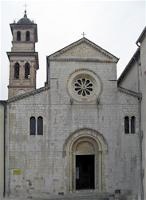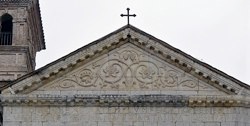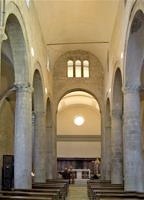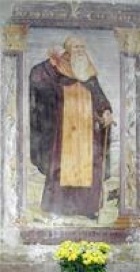


According to local historians, a Benedictine abbey was established here in 1158. The inscription (see below) under the tympanum records the church as the work of Atto, who might have been the artisan recorded in other inscriptions on the facades of:
-
✴San Lorenzo, Spello, in 1120; and
-
✴the Duomo, Foligno, in 1133.
The abbey is first documented in 1177, when Pope Alexander III confirmed its jurisdiction over a number of churches in the area. The church and hospice of Santo Stefano in Trevi were among its possessions at that time. An inscription on the wall of the ex-hospice imposes a curse on Pope Gregory XI (1370-8) who had apparently violated the rights (presumably the property rights) of the abbey.
The abbey declined after the destruction of Trevi in 1214. St Francis stayed here at about this time, when the abbey was effectively abandoned. This was the occasion on which Brother Pacifico had a vision in which the empty throne of the fallen Lucifer was reserved for St Francis.
The monks subsequently returned, but a bitter dispute arose in 1265, when two abbots were elected:
-
✴Grifo, a monk from Todi: and
-
✴Ruggero, abbot of the Camaldolesian Abbazia di San Silvestro, outside Spello.
Pope Bonifacio VIII mandated Gerardo, bishop of Spoleto, to adjudicate. He ruled in favour of Ruggero, who remained in post until his death in 1335.
The abbey was damaged in the wars between Guelfs and Ghibellines in the 14th century. In 1334, just before his death, Abbot Ruggero unilaterally united it with Santa Croce di Sassovivo (outside Foligno) and transferred all its goods and rights to this institution. The papal legate, Cardinal Giovanni Gaetano Orsini agreed, but the union could not be effected because of [Ghibeline opposition ??].
This was the start of a tortuous dispute that re-erupted in the 15th century:
-
✴In 1421, Pope Martin V instructed Bishop Nicolò of Foligno to put the union into effect provided that all the monks agreed. However, he found that there was no agreement and nothing was done.
-
✴Corrado Trinci, Lord of Foligno took over the abbey in 1421 during his war with the Manenti family, which had begun after the murder of his brother at Nocera. This allowed the Abbazia di Sassovivo finally to take over the goods and rights in question.
-
✴However, Pope Eugenius IV re-established the abbey's independence after he defeated and executed the Trinci in 1439. He appointed Tommaso Valenti as abbot and mandated the papal governor, Archbishop Gaspare of Naples, to adjudicate the dispute with Sassovivo. The archbishop ruled in favour of the abbey’s independence.
San Martino della Pieve, the original parish church of Trevi, had lost this function in 1430. Its site seems to have belonged to the Abbazia di San Pietro in Bovara, because it was Tommaso Valenti who ceded it to the Observant Franciscans in 1479, with the approval of Pope Sixtus IV. The Franciscans used the site for their new church of San Martino.
Despite the best efforts of Abbot Tommaso, the abbey’s property was never fully recovered. He secured the agreement of Sixtus IV to transfer the abbey to the Olivetans in 1484, in order to facilitate the reform of its religious practices. The Olivetans initially nominated a prior, but Tommaso Valenti was still honoured as abbot until his death in 1490.
The abbey now began to recover its former standing. The Commune entrusted the Olivetans with responsibility for the construction of the new church of Santa Maria delle Lacrime in 1485. The transfer was initially contested, but Pope Innocent VIII approved it in 1489. Construction was still incomplete in 1500, when the Commune reclaimed the church from the Olivetans.
Pope Paul III and his court stayed at San Pietro in Bovara in 1545, en route from Perugia to Rome.
The abbey was suppressed in the Napoleonic period. The Curia subsequently recovered it but transferred it to the Martinez family in payment of a debt. The church now serves the local parish.
Stele of Bovara (late 3rd century BC)
The so-called Stele of Bovara, which bears an early Latin inscription was discovered near the church in the 1950s. This inscription, which is now in the Museo della Città e del Territorio, was probably associated with the nearby Roman colony at Spoletium (as also described on the page Latin Inscriptions after 295 BC).
Exterior
The structure of the facade reflects the nave and lower flanking aisles within. The portal, the two bifore windows and the central part of the rose window were replaced in an excellent restoration in 1886. The fine campanile (1622) was built after its predecessor was destroyed by an earthquake.
Tympanum

[more: Tempietto di Clitunno];
The two-line inscription below the tympanum reads:
Atto sua dextra templum fecitque fenestram.
Cui Deus eternam vitam tribuatque supernam
(Atto, with his right hand, made the temple and the window to whom God grants eternal life).
Relief (perhaps 8th century)

This relief below the rose window, with two corbels of cows heads above it.
Interior

The apse was rebuilt after the earthquake of 1582. The carved choir dates to 1610. The rest of the church took on its current austere appearance after the restoration of 1951-2, when a series of stucco altars along the side wall was removed.
The Crucifix (ca. 1330) in the chapel at the head of the left aisle is reputed to be that which St Francis venerated, although recent study has confirmed that it dates to a later period.
St Antony Abbot (1553)


